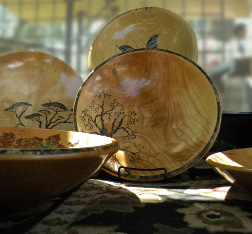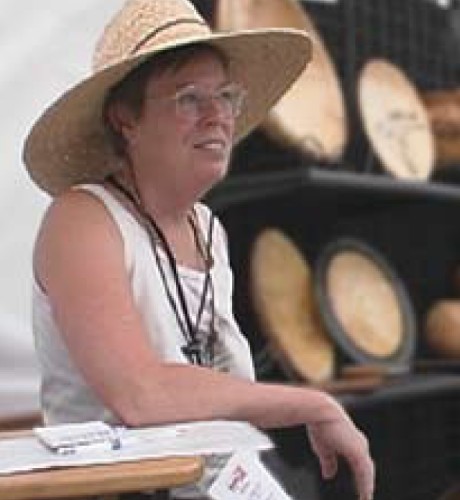Farmer’s Market Stories
Salt Lake City is home to a true urban forest, many city trees are over 100-years-old. This is in large part due to industrious Pioneers who planted a variety of trees in their vision to “make the desert blossom as the rose.” Unfortunately, some of these trees have run their course and for whatever reason old trees die. Incredibly, most of the old growth wood ends up in landfills, fireplaces, or wood chippers. Kurt Bellock was burning some of this gorgeous wood one night when he realized what a terrible tragedy it was to waste such a valuable commodity.

Bellock tried offering his prized old growth wood to carpenters and carvers but they refused because the wood was too difficult to work with. This sent Bellock on a path that would offer him a new hobby and eventually a new career. His refusal to allow this “spectacular wood” simply go to waste, sent him to Oregon to learn how to turn wood into bowls using a lathe. After returning home, Bellock built his own lathe and began turning wood bowls then eventually selling his pieces at local art shows and in the Farmers Markets in Salt Lake City.
Before becoming a full-time bowl carver, Bellock was the owner of a successful construction company. Bellock says he has taken a pay cut shifting from a contractor to artisan, however the satisfaction and enjoyment he receives from is work today has made him more content.
Also, his work has offered the Bellock’s a great opportunity to travel the country selling their pieces in some of the best art shows in the West, most recently the Kimball Arts Park City Arts Festival.
Kurt Bellock has combined his efforts with his wife Melody, who provides exquisitely carved stone inlays into Kurt’s pieces. These inlays turn his crafted bowls into fine works of art. Melody Bellock began working helping Kurt by filling in cracks as well as finishing the surface of his bowls. Later she experimented with various filler materials to repair cracks. Eventually, she found how to inlay turquoise and other stones into large cracks. As Melody refined her technique she began to notice how the cracks resembled trees, and the wood grains offered a natural canvas for foreground images. Naturally artistic as a life-long musician, Melody says she has been refining her technique and style, where today she feels the results she achieves are constantly improving.
Melody begins by sketching her forground image onto the bowl, then she picks out minerals for the colors she wants to use: mica for black, mica and small fine crystals for gray. calcite, turquoise, malachite, and a huge variety of beautiful stones and minerals make up Melody’s palette.

Once the stones are in place, Melody binds the stone with the wood using super glue injected from a syringe. This technique makes it impossible for the stone to fall out of the inlay. Kurt then spends hours sanding away at the glue and rock until the surface is smooth. Melody then puts additional layers of stone before the final sanding and finishing of the pieces. Then they complete their pieces with twelve coats of tongue oil.
The scale and efficiency of the Bellock’s operation is impressive. Both have their own workshops; both also have the very best tools and equipment for their jobs. Melody uses two separate dremel tools for carving inlay: one large bit removes large areas of material, and one small bit dremel is used for fine details. Kurt has invested in a $7,000 lathe that can handle widths up to 40” in diameter. The shop’s efficiency is a reminder of how seriously they take their business and operation, which is an obvious reason for their success.
When the Bellocks do take a break, they introduce me to their beautiful exotic chickens. The Belloks say their chicken’s dust baths are a joy to sit and watch. Then Melody invites me inside where she plays classical music on her harp. After two quick songs (which can be heard in online video), its back to work.
The magic of the completed bowls is how the wood grains and stone complement each other so well. The bowl I watch Melody carve has a rainbow trout among swirling waves of wood grain and big rocks. The rocks are knots in the wood and the waves are the natural pattern to the old growth grain. §

